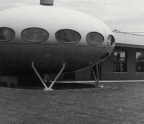
In 1889, in anticipation of the four-hundredth anniversary of the arrival of Christopher Columbus, delegations from the “New World” cities of New York, Chicago, St. Louis, and Washington, DC, competed vigorously for the prestige and economic boost of hosting a world’s fair on American soil. On February 24, 1890, recognizing the city’s resurrection following the devastating fire in 1871, Congress invited the world to the “Phoenix City of the Great Lakes”: Chicago.1

The site selected for the 1893 World’s Fair, also known as the Columbian Exposition, encompassed more than six hundred swampy acres stretching along the city’s southern Lake Michigan shore to the southern extremity of Jackson Park. This area would be reworked into a palatial park with moving sidewalks, exposition halls, the country’s first Ferris wheel, and the Manufactures and Liberal Arts Building, touted as “one of the wonders of the world … the largest structure ever built.”2 In addition, the Fair’s board of directors gave each US state and countries from throughout the world the opportunity to erect a representative structure. Like the Fair itself, almost everything created was intended to be temporary and would be removed at the Fair’s close. Impressive neoclassical buildings, statues, and other structures were nothing more than metal or wood frames with staff (a mixture of powdered gypsum, cement, glycerin, and dextrin) and plaster coverings meant only to endure the Fair’s six-month run. Although temporary, their design would influence architecture for years to come.
In May 1892, the Norwegian government, which was largely independent but shared a king and foreign affairs with Sweden, decided to participate in the Fair and established a committee to plan exhibits. Norway’s representatives originally hoped for a large “Norwegian Building” to house the country’s exhibits under one roof. But with a late start and less space at the Fair site than they had hoped for, the original plans were abandoned.3
Instead, the Norwegian committee decided to scatter small exhibits of manufactured and artistic goods amongst the various divisions of the Fair. They entered an industrial display in the Manufactures and Liberal Arts Building. Costumes were exhibited in the Women’s Building. In the Arts Building, 150 paintings represented forty-five Norwegian artists. The country had a sizable presence in the Fisheries Building.4 In addition, Captain Magnus Anderson, editor of the Norwegian Seaman Gazette, inspired individual Norwegians to donate money toward building a replica of a recently unearthed Viking ship that he and some dozen volunteers would eventually sail successfully across the Atlantic. They hoped to prove that Norwegians could have been the first Europeans to land in America.

The committee opted to build a meeting hall in the style of a stave church, a classic Norwegian structure characterized by interior timber framework and Hansteen’s employer, Thams & Co., which specialized in prefabricated frame houses, was selected to execute the work according to Hansteen’s drawings. Negotiations were closed by contract in November 1892, and the company promised to complete the building in Chicago in February 1893 for a price of 6,000 kroner. Freight from Norway and setup in Chicago would be at the committee’s expense.




